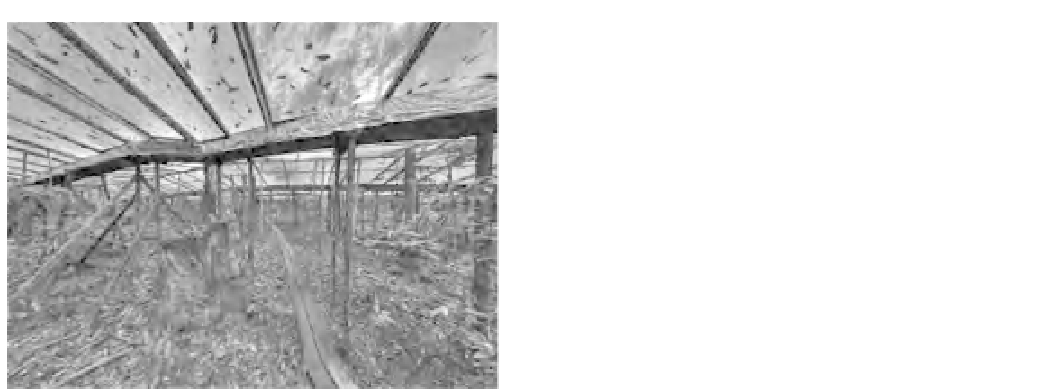Environmental Engineering Reference
In-Depth Information
so, it enables information on soil physical properties,
rooting strategies, plant conductance to water and plant
hydraulic strategy to be incorporated in model predic-
tions, theoretically allowing the model mechanisms to be
employed in situations where such properties differ. The
SPA model uses several of the simplifying assumptions
discussed in the previous section. It uses the Farquhar
model of photosynthesis to predict carbon-assimilation
rates, Beer's law to predict the transfer of light through
the forest canopy and the Penman-Monteith equation
to predict water use by leaves. In addition, stomatal con-
ductance is estimated so as to satisfy the dual constraints
of maximizing photosynthetic uptake while keeping leaf
water potential higher than a critical minimum threshold.
In this version of the model, the conductance of plant
tissues to water was kept constant, so the model assumes
that all temporal changes in water transport occur in the
soil matrix. This assumption is consistent with similar
estimates of
in situ
branch conductance made at the same
site in the wet and dry seasons and with measurements
of the division between above and below ground
conductance to water, which indicate a dominance of
below-ground transport limitation in the dry season.
The dominance of soil-to-root water transport in dry
conditions is expected when root densities are relatively
low (Sperry
et al
., 1998), and at this site, rooting depth
was at least ten metres, increasing the distance water has
to travel to arrive at the soil surface, on average.
To maintain independence between the model pre-
dictions and the validation data, these model processes
were parameterized as far as possible using measurements
that were independent of the validation data. These mea-
surements included leaf-level estimates of the parameters
of the Farquhar photosynthesis model, measurements
of the hydraulic conductivity of branches (Sperry and
Tyree, 1988), measurements of the observed minimum
leaf-water potential and of the hydraulic properties of
the soil matrix, the leaf-area index of the canopy, the
root-biomass profile and the vertical distribution of pho-
tosynthetic capacity. The model was then driven using
half-hourly meteorological data collected at the field-site,
and its predictive ability was assessed by comparing the
output with seasonal patterns of sap-flow and soil mois-
ture content (Fisher
et al
., 2007) and diurnal patterns
of leaf and stem water potential, sap flow and leaf-level
stomatal conductance (Fisher
et al
., 2006). The model was
found to produce reasonable simulations of all of the dif-
ferent data streams, including the water use (Figures 12.5
and 12.6), stomatal conductance and leaf water potential
Figure 12.4
Throughfall exclusion experiment at Caxiuana,
Para, Brazil. One hectare of plastic panels intercept rainfall and
drain it away from the manipulation experiment in wooden
aqueducts, preventing
∼
50% of water from reaching the soil
surface (Reproduced with permission from Fisher
et al
. 2007,
Global Change Biology. Permission Pending. Fisher, R.A.,
Williams, M., Lola da Costa, A.
et al
. (2007) The response of an
Eastern Amazonian rain forest to drought stress: results and
modelling analyses from a through-fall exclusion experiment.
Global Change Biology
, 13, 1-18).
These shelters intercepted
∼
50% of the incoming rainfall,
draining it away from the soil and imposing drought con-
ditions on the treated area (Figure 12.4). At Caxiuana,
in north-eastern Brazil, soil-moisture content and tree-
water use, or sap flow, were measured throughout the
course of the experiment. Soil-moisture content declined
in the droughted plot quickly, relative to the paired con-
trol, followed by a sharp decline in the water use of the
trees, as drought stress slowed their rate of transpiration.
One way to interpret these results is to plot an empir-
ical relationship between water use and soil-moisture
content, and feed this relationship into traditional
vegetation models. However, this extrapolation method
means that the relationship is not appropriate for
conditions not exactly analogous to those under which
the data were collected. To address this problem, the
data from the experiment were instead used to verify the
mechanisms in a more 'mechanistic' model, to validate
that the underlying understanding of ecosystem function,
as represented by the model, was able to reproduce the
patterns observed in the data. The model employed was
the 'soil-plant-atmosphere' model (SPA, Williams
et al
.,
1996), which is one of the only soil-atmosphere-transfer
models to employ an explicit simulation of the transport
of water between the soil matrix and the leaf. By doing

Search WWH ::

Custom Search